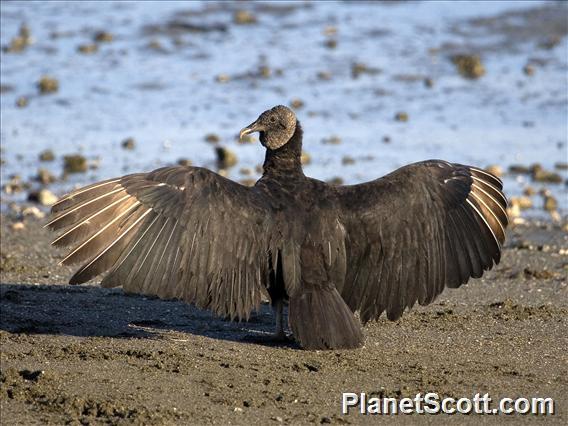Black Vulture (Coragyps atratus)









About Black Vulture (Coragyps atratus)
- Kingdom: Animals
- Phylum: Chordates
- Class: Birds
- Order: Vultures
- Family: New World Vultures
The black vulture, also known as the American black vulture, Mexican vulture, zopilote, urubu, or gallinazo, is a bird in the New World vulture family whose range extends from the southeastern United States to Peru, Central Chile and Uruguay in South America, and common throughout Brazil where it can be seen in large scavenging groups. Although a common and widespread species, it has a somewhat more restricted distribution than its compatriot, the turkey vulture, which breeds well into Canada and all the way south to Tierra del Fuego. It is the only extant member of the genus Coragyps, which is in the family Cathartidae. Despite the similar name and appearance, this species is not closely related to the Eurasian black vulture, an Old World vulture, of the family Accipitridae. For ease of locating animal corpses, black vultures tend to inhabit relatively open areas with scattered trees, such as chaparral, in addition to subtropical forested areas and parts of the Brazilian pantanal.
Source: Wikipedia
Trips
Visits
-
2001-12-28
Puerto Vallarta, Mexico -
2006-11-11
Sani Lodge, Ecuador -
2006-12-19
Puerto Quito, Ecuador -
2006-12-20
Milpe, Ecuador -
2007-10-10
Cardel, Mexico -
2007-10-17
Sontecomapan, Mexico -
-
2009-01-14
Cozumel, Mexico -
2009-01-18
Lamanai Ruins River Trip, Belize -
2009-02-03
Los Tarrales, Guatemala -
2009-02-18
Parque National Palo Verde, Costa Rica -
2009-02-24
Puerto Jiminez, Costa Rica -
2009-02-25
Corcovado National Park - La Sirena, Costa Rica -
2009-03-01
Volcan Baru, Panama -
2009-03-05
Isla Coiba, Panama -
2009-03-15
Boca de Cupe, Panama -
2010-02-20
Temescaltepec, Mexico -
2010-02-21
Taxco, Mexico -
2010-02-21
Grutas de Cacahuamilpa, Mexico -
2010-06-21
Cape May Point State Park, United States of America -
2011-07-10
Santa Fe River, United States of America -
2011-07-11
Ocala National Forest, United States of America -
2011-07-14
Chapada dos Guimaraes, Brazil -
2011-07-15
Pantanal, Brazil -
2011-07-21
Itacare, Brazil -
2013-03-04
John Heinz NWR at Tinicum (IBA), United States of AmericaSeen from the car a few miles from the refuge. -
2013-04-14
Austin, United States of America -
2013-04-15
Balcones Canyonlands NWR--Refuge HQ (Travis Co.), United States of America -
2013-04-17
Brazoria NWR (UTC 108), United States of America -
2013-04-19
Bolivar Peninsula, United States of America -
2013-04-20
Attwater Prairie Chicken National Wildlife Refuge, United States of America -
-
-
-
-
-
-
-
-
-
-
-
-
-
-
-
-
-
-
-
-
-
-
-
-
-
-
-
-
-
-
-
-
-
-
-
-
-
-
-
-
-
-
-
-
-
-
-
-
-
-
-
-
-
-
-
-
-
-
-
-
-
-
-
-
-
-
-
-
-
-
-
-
-
-
-






